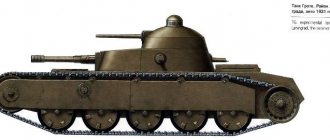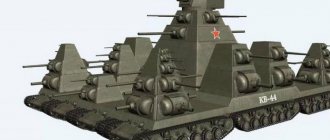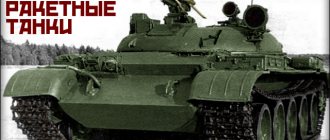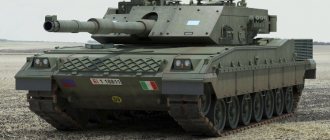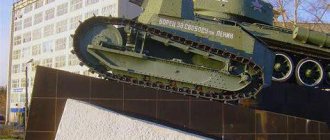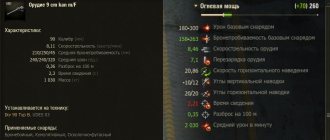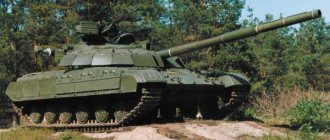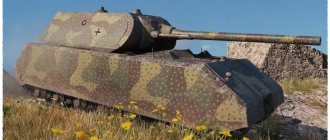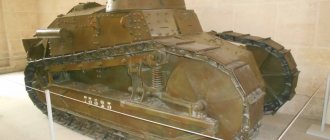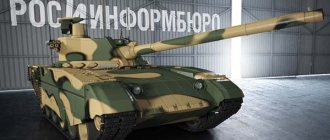The tank is a unique combat vehicle that radically changed the face of war in its time. From the moment of its first appearance on the battlefield to this day, the very appearance of the tank has changed. The school of tank building does not stand still, and its brainchild itself is evolving along with it. In different eras, these steel “chariots of death” looked different, embodying the ideas and needs of their time.
In the first half of the twentieth century, the idea of multi-turret tanks was popular among designers of leading powers. It seemed to tank builders that a larger number of turrets should enormously increase the firepower of a combat vehicle. However, further experience in using such “steel monsters” showed their low efficiency and therefore there are no modern tanks of this design. But at a certain point in time, the development of such “mobile fortresses” was actively carried out in many countries. Some of them remained prototypes, and some were even put into service and participated in combat operations. The USSR, like many other countries, was also not spared by the fashion for “multi-towers”.
We present to your attention the TOP 5 Soviet serial and experimental multi-turreted tanks according to the website slovodel.com.
5th place: T-29
ru.
wikipedia.org The T-29 tank combined a multi-turret design and another popular tank design idea of the time, namely a wheeled-tracked base. Many people are familiar with the light Soviet high-speed tanks of the BT series on a chassis similar in concept. But this combat vehicle was designed on the basis of another wheeled-tracked tank: the amphibious PT-1.
The T-29 is a medium three-turret wheeled-tracked tank of a classical layout with bulletproof and anti-fragmentation armor, the design of which was largely the same as that of the T-28.
The central main turret, located on the second tier, was a slightly modified turret from the T-26-4, into which the KT-28 cannon was installed; there were also attempts to install the PS-3 cannon, but ultimately it was decided to install a 76-mm L-10 gun. 7.62 mm DT machine guns were located in ball mounts on the front and rear sides of the turret.
DT machine guns were also installed in two additional turrets located in the front of the hull on the first tier.
The T-29 had good driving characteristics. He was quite fast and maneuverable. The maximum speed on wheels (on the highway) was about 80 km/h, on tracks – about 50 km/h (on highways and rough terrain).
This combat vehicle was developed in the 1930s. In the period from 1934 to 1937, 5 prototypes were built, which passed the tests quite successfully. The tank was planned to be adopted by the Red Army, but this tank did not go into production due to its complex design.
IS-2 tank in popular culture
The heavy tank was used in the films “Father of a Soldier” as an independent model. Several films were restyled to depict different cars. In “Blockade” - KV-1, in “Tank “Klim Voroshilov” - KV-2, in “In War as in War” - Panther, in “White Tiger” - Tiger. The Pravda team from the animated cartoon Girls und Panzer rode this exact model.
The creators of computer games - simulators and strategies - idealize the IS-2, reflecting far from real performance characteristics. The tank can be seen in World of Tanks, Blitzkrieg, Sudden Strike, Order of War, RUSE and others.
The Soviet heavy vehicle became a worthy successor to the KV-2 attack aircraft. Despite its massiveness and external clumsiness, the weapons turned out to be effective during the offensive. Mobility, good protection and a powerful long-range cannon made the tank a real striking force of the Red Army.
4th place: T-100
en.wikipedia.org
The T-100 is a heavy experimental double-turret tank with a classical layout, developed at the end of the popularity of such designs. In fact, it was one of the last projects of multi-turret Soviet tanks.
The tank turrets were located one after the other and thus formed two tiers. On the first there was an auxiliary turret with a 45-mm 20-K cannon, which was designed to destroy armored vehicles.
Behind it, forming a second tier, was installed the main turret, equipped with a 76-mm L-10 cannon to destroy enemy personnel and fortifications.
The combat vehicle was also armed with three 7.62-mm DT machine guns: two in the turrets and one in the commander’s cupola.
In addition to firepower, the T-100 was also well armored for its time. It had basically 60 mm of armor all around, both in the hull and in the turrets. Such armor made it possible to “take a blow” quite decently.
This tank was manufactured in a single copy in 1939 and was tested until 1940. Despite the fact that it was a prototype, it still managed to take part in combat operations. Along with several other experimental tanks, the T-100 was used in battles on the Mannerheim Line during the Finnish War. The tank showed positive results, but it was never put into production. The commission gave preference to the more promising KV-1 tank, abandoning the idea of a complex multi-turret design.
Modifications
The released IS-2 tanks, despite the design differences, were not separated into separate modifications. Only in 1957, after the decision was made to modernize the vehicles, the IS-2M version appeared - the vehicles were converted into it during a major overhaul.
The IS-2M was equipped with new V-54K engines, a gearbox oil cooler, and night vision devices. The rear machine gun was abolished, the ammunition load was increased (increased to 35 rounds), and the external tanks included a general power supply circuit. All surviving vehicles were brought to the new standard, including the IS-2 of the first production with a “broken” frontal part.
Variants such as “IS-2Sh” appearing in some online games are fiction.
3rd place: SMK
commons.wikimedia.org
Bronze is taken by another two-turret “heavyweight” of the Soviet tank industry, which suffered the same sad fate as the previous model, which was developed in parallel with the SMK and underwent combat tests side by side with it.
The SMK was a heavy tank with two turrets of a classic layout. The turrets of the combat vehicle were also located in two tiers: the auxiliary one was on the first in front, the main one was on the second tier behind it.
The auxiliary small turret contained the same 40-mm 20-K cannon as on the T-100. The main turret was already equipped with a 76-mm L-11 gun, which was a modernized L-10 tank gun, which could be found on many Soviet tanks of those years, including the competing Sotka.
In addition, the SMK was armed with four 7.62 mm DP machine guns and one DShK heavy machine gun, 12.7 mm caliber.
In terms of armor, this model was superior to the well-protected T-100. The SMK also had 60 mm of armor in the turrets, but this tank already had 75 mm of armor in the hull.
QMS was also developed in the late 1930s. Like the T-100, it was produced in a quantity of one unit and was sent to the Mannerheim Line to be tested in combat conditions. In general, the combat vehicle met the operational and tactical requirements, but, like its competitor, the SMK was rejected by the commission for the same reasons; in addition, the tank was too heavy and too large.
Crushing ST-II
In 1945, preliminary technical designs for heavy tanks ST-I and ST-II were created - with two guns. Design engineers of the Central Artillery Design Bureau A. S. Chasovnikov and V. A. Ganin worked on them.
In the game, ST-II promises to be a big problem for the enemy, especially with the support of allies. The best way to play this tank is to take advantage of the excellent gun depression angles and constantly maneuver under enemy fire, making it difficult for him to aim.
ST-II is equipped with two 122 mm guns, each with a one-time damage of 440 units. The limited mobility of this heavy machine means you need to choose the direction in which you will operate. It will not be possible to quickly change flank on ST-II.
We are confident that these powerful Soviet double-barreled tanks will be a breath of fresh air and will introduce many new tactical options to the gameplay. Good luck on the battlefields!
2nd place: T-28
en.wikipedia.org
In second place we have the T-28 tank from the 30s of the 20th century, the first medium tank in the USSR to be put into mass production.
T-28 is a medium three-turreted infantry support tank with a classic layout and bulletproof armor. The prototype of this combat vehicle was the British Vickers 16-ton tank, inspired by which after a visit to Great Britain, Soviet tank builders began to develop their own analogue.
Structurally, it is similar to the already mentioned T-29, the progenitor of which it was. The towers are located in the same way: two machine gun towers in front on the first tier and the main cannon tower on the second.
In two small turrets located in front on the first tier, one 7.62-mm DT machine gun was installed, which made it possible to effectively fight the advancing enemy personnel in two directions.
The main turret was a modified version from the turret of another multi-turret T-35 tank. Initially, it was equipped with a short-barreled 76-mm KT-28 cannon, which was a modification of the regimental gun of the 1927 model. Starting from 1938, the tank was already equipped with a more modern L-10 tank gun with a similar caliber, which was superior in performance to the old KT-28. Two DT machine guns were also installed in the turret.
The tank was produced from 1933 to 1940. A large number of T-28s were produced: 503 units. At the time of its creation, it was the most powerful tank in the world. The first combat use took place during the Winter War, as a result of which it was decided to shield the combat vehicle with additional armor; starting from 1940, 111 units were modified. This modification received the index T-28-E.
This tank was also used in the initial stages of the Great Patriotic War, but by that time it was already obsolete and most of the combat vehicles were lost in the first months.
Alternatives
| An alternative to the multi-turret layout was the barbette layout, which provided for the placement of a cannon sponson and several machine-gun barbettes on different sides of the fighting compartment. This kind of design concept was embodied in American medium tanks (right) and (left) |
design with multiple barbettes and sponson-mounted gun
) - a set of design solutions characteristic of the American tank building of the interwar period and the initial stage of World War II, designed to solve the problem of increasing the fire capabilities of the tank as a whole and its fire performance in particular by adding a rotating gun assembly (sponson) in the frontal part to the design of the armored hull of the tank and protruding corner machine-gun nests (barbettes) on two sides in front of the turret or on four sides on the sides of the turret in front and behind. This design technique made it possible to retrofit the tank with a more powerful tank gun in the sponson for firing at targets in the direction of movement and two or four machine guns. The authors of this type of tank building technology should be considered the engineers of the Aberdeen Tank Proving Ground, who were responsible for the design and field testing of prototypes of the named production models. American tanks differed from their Soviet counterparts of those years—multi-turret tanks of the T-35 type—by being significantly lighter (two to four times lighter) with similar or comparable armament. This principle was used to design serial medium tanks, the M3 "Lee" and "Grant", and a number of experimental prototypes that did not go into mass production[17].
Notes
- ↑ 1234
Pre-war tanks (20-30s). Basic theory and history of the development of the tank layout. V. Chobitok. Equipment and weapons. 2004. No. 4, 5, 7, 9, 10 - https://armor.kiev.ua/wiki/index.php?title=Basics_of_theory_and_history_of_development_of_tank_layout. Pre-war tanks (20-30s). Basic theory and history of the development of the tank layout. V. Chobitok. Equipment and weapons. 2004. No. 4, 5, 7, 9, 10
- ↑ 12
Kholyavsky, 1998, p. 132. - ↑ 1 2 3 Gordon, Jim
. Why don't tanks have two or more turrets? (English) (electronic resource). — 21 January 2015. - Popov et al., 1988, p. 40-41.
- Anderson, Thomas
. The History of the Panzerwaffe. Volume 1: 1939-42 (English). - Oxford: Osprey Publishing, 2015. - P. 28, 271-304 p. — ISBN 978-1-4728-0812-7. - Kolomiets, 1998, p. 8.
- Govan, Gregory. The Tank Builders, 1979, p. 21.
- Tank T-26 model 1931 - Great Military Encyclopedia
- TANK T-28 - a large encyclopedia of tanks
- Kolomiets, 2000, p. 37-39.
- Kolomiets, 2000, p. 14-21.
- Zaloga, Steven. Armored Champion, 2015, p. 60.
- ↑ 12
Kholyavsky, 1998. - Zaloga, Steven. Armored Champion, 2015, p. 94.
- Zaloga, Steven. Armored Champion, 2015, p. 95.
- Ogorkiewicz, Richard
. Tanks: 100 Years of Evolution. - Oxford: Osprey Publishing, 2015. - P. 31, 37, 53, 61, 83-86 - 376 p. - (General Military) - ISBN 978-1-4728-0670-3.
Literature
- Zaloga, Steven
. Armored Champion: The Top Tanks of World War II. (English) - Mechanicsburg, PA: Stackpole Books, 2015. - 336 p. — ISBN 978-0-8117-1437-2. - Bishop, Chris
. The Encyclopedia of Weapons of World War II. (English) - NY: MetroBooks, 2002. - 544 p. — ISBN 1-58663-762-2. - Smith, Matthew L.
Lessons Learned from 20th Century Tank Warfare: Does a Canron Thread of Lessons Exist? (English) - MMAS Thesis. - Fort Leavenworth, Kansas: US Army Command and General Staff College, 1988. - 112 p. - Govan, Gregory G.
The Tank Builders: A History of Early Soviet Armor Research and Development. (English) - Research Report - Garmisch: US Army Russian Institute, 1979. - 57 p. - M. Kolomiets, I. Moshchansky.
Armored vehicles of France and Italy 1939-1945. - Moscow: Modelist-Constructor, 1998. - 32 p. - (Armor collection). - Kolomiets M.
Multi-turret tanks of the Red Army, part 1. - M.: KM Strategy, 2000. - 80 p. — (Front-line illustration No. 4 / 2000). — 1500 copies. — ISBN 5-901266-01-3. - Kolomiets M., Moshchansky I.
Medium tank T-28 / M. B. Baryatinsky. - M.: Modelist-constructor, 2001. - 32 p. — (Armor collection No. 1 (34) / 2001). — 4500 copies. - Kolomiets M.
Medium tank T-28. Stalin's three-headed monster. - M.: Eksmo, 2007. - 112 p. — (War and us. Tank collection). — 4500 copies. — ISBN 978-5-699-20928-6. - Kolomiets M.
Land battleships of Stalin. - M.: Eksmo, 2009. - 320 p. - (Weapon of Victory). — 4000 copies. — ISBN 978-5-699-34275-4. - Kolomiets M.V.
Captured tanks of the Red Army. On the "tigers" to Berlin! - M.: Yauza; KM strategy; EKSMO, 2010. - 112 p. — (War and us. Tank collection) — ISBN 978-5-699-40230-4. - N. Popov, M. Ashik, I. Bakh and others.
Designer of combat vehicles [About Zh. Ya. Kotin]. - L.: Lenizdat, 1988. - 382 p. — 3000 copies. - M. Svirin.
Stalin's armor shield. History of the Soviet tank. 1937-1943. - M.: Yauza, Eksmo, 2006. - 448 p. — 3000 (additional) copies. — ISBN 5-699-16243-7. - M. Svirin.
Tank power of the USSR. - M.: Yauza, Eksmo, 2009. - 640 p. — 3500 copies. — ISBN 978-5-699-31700-4. - Solyankin A. G., Pavlov M. V., Pavlov I. V., Zheltov I. G.
Domestic armored vehicles. XX century 1905–1941. - M.: "Exprint", 2002. - T. 1. - 344 p. — 2000 copies. — ISBN 5-94038-030-1. - Kholyavsky G. L.
Encyclopedia of tanks. - Mn.: Harvest, 1998. - 576 p. — 5000 copies. — ISBN 985-13-8603-0.
